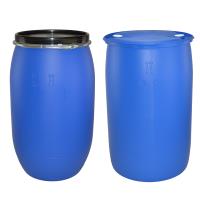 Add My Company
Add My Company
Sign In

Blue plastic drums are a classic sight in warehouses, storage containers and transport facilities across the world.
These rigid, sturdy containers are perfect for holding large quantities of goods, from oils and food through to hazardous waste and dangerous chemicals.
But there are two fundamental varieties of blue plastic drum to choose between, and it’s important to know which best meets your needs.
The two types of plastic drum you need to consider are open-head and tight-head drums.
In this article, we explain the differences.
WHAT IS AN OPEN-HEAD PLASTIC DRUM?
An open-head plastic drum is also known as an open-top plastic drum, for the simple reason that the top lid can be completely removed.
Open-head plastic drums can be left open-topped (with no lid), or sealed with a secure lid and fastenings for transport or storage purposes.
The container will be filled, and emptied, from the top because it is the only opening.
This style of plastic drum comes in a wide variety of different sizes, ranging from small 30-litre drums through to large 220-litre models.
Open-head plastic drums are durable, resilient, and strong enough to hold hazardous waste.
WHAT IS A TIGHT-HEAD (CLOSED-HEAD) PLASTIC DRUM?
A tight-head plastic drum is sealed at the top and bottom.
They have a closed head, meaning that there’s no removable lid at either end.
Tight-head plastic drums are therefore completely sealed, aside from one or two designated openings that are used to funnel liquids in or out. These small openings are themselves sealed with a bung or a similar, secure stopper.
Because they’re sealed, tight-head drums are often thought to be more secure than open-head plastic drums.
They are manufactured in a narrower range of sizes, from 120 litres through to 220.
WHAT TYPE OF CLOSURES ARE AVAILABLE FOR BOTH?
There are different closures available for both open-head and tight-head plastic drums.
An open-head drum will have a removable plastic lid. The most secure way to fasten it to the drum is by using a steel clamp, holding down a steel closing ring. These closures are highly secure and tamper-proof, allowing you to transport goods safely with full peace of mind.
Tight-head plastic drums have only one or two small openings, usually on top of the drum or on the side. These are sealed tightly with an industrial threaded bung closure during storage and transport. They can be fitted with a nozzle or tap, to release the liquid from the drum later (think of a wine casket or beer barrel; it’s the same principle).
HOW DO I KNOW WHICH PLASTIC DRUM TO CHOOSE BASED ON THE MATERIAL BEING SHIPPED OR STORED?
Tight-head drums are best suited to the storage and transport of liquids because the contents need to be easily funnelled in and out of the drum.
They work well for oils, large quantities of a beverage, or similar. Tight-head drums provide more security for liquids than an open-head alternative.
Semi-solids, powders, and thick liquids are better stored in open-head plastic drums because they’re much easier to get in, or out, when you can take the lid off.
Foodstuff is often stored in an open-head drum, while they are also used for hazardous wastes or chemicals.
Always check that the plastic drum you are using is certified to hold any dangerous or hazardous chemicals or substances first.
WHAT ARE THE CONSEQUENCES OF USING THE WRONG PLASTIC DRUM?
Using the wrong plastic drum can have disastrous consequences on your products, your business and, more importantly, on health and safety.
It’s your responsibility to transport and store your products correctly and you can be fined for following incorrect procedures.
If there are dangerous spills because you used an open-head drum to carry liquids instead of a closed-head one, then you could potentially be vulnerable to prosecution.
You put not only yourself and your business at risk, but the health and safety of others too.
GET IN TOUCH FOR EXPERT ADVICE
Our professional staff are happy to help you navigate through the complex world of plastic drums to ensure you have the most suitable product for your needs.
If you’re still unsure whether your business needs an open-head or a tight-head plastic drum, contact ITP Packaging for expert advice.
For more information on What is the difference between an open-head and tight-head plastic drum? talk to ITP Packaging Ltd
Enquire Now
List your company on FindTheNeedle.

